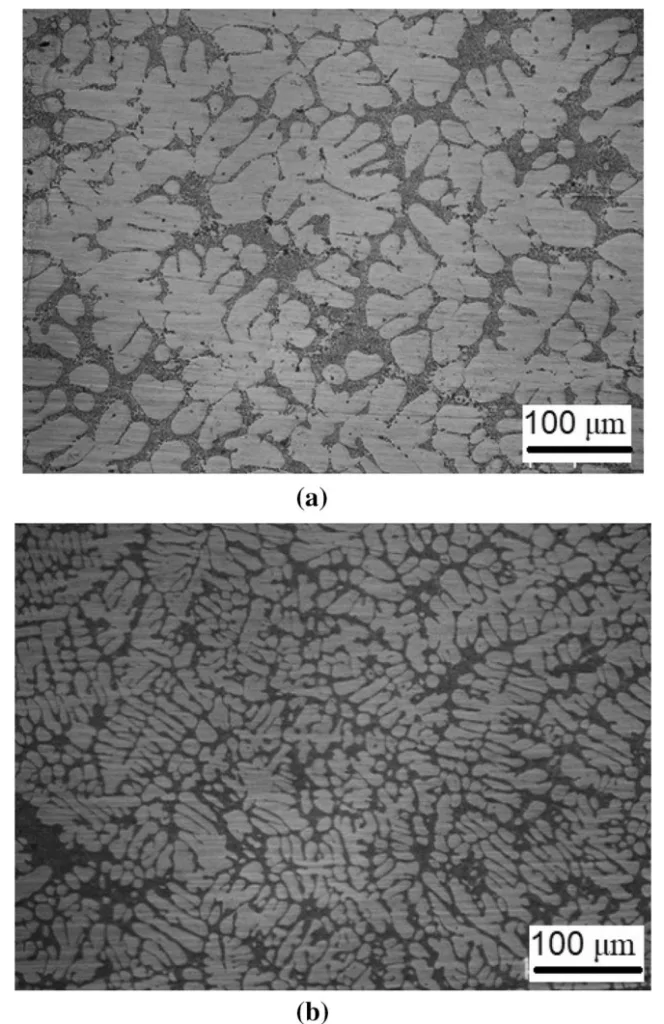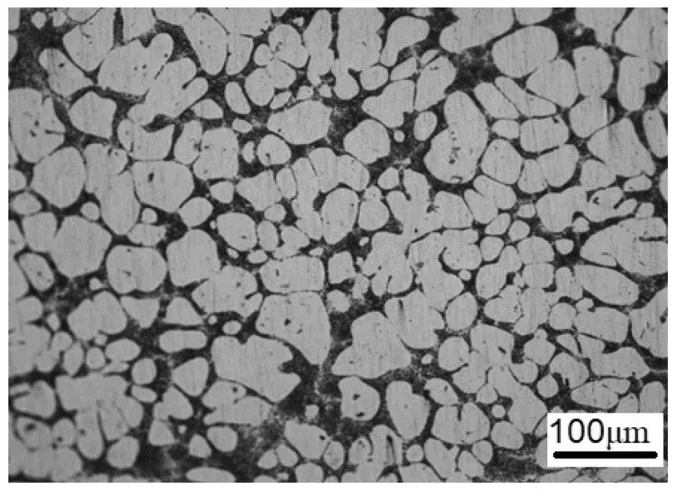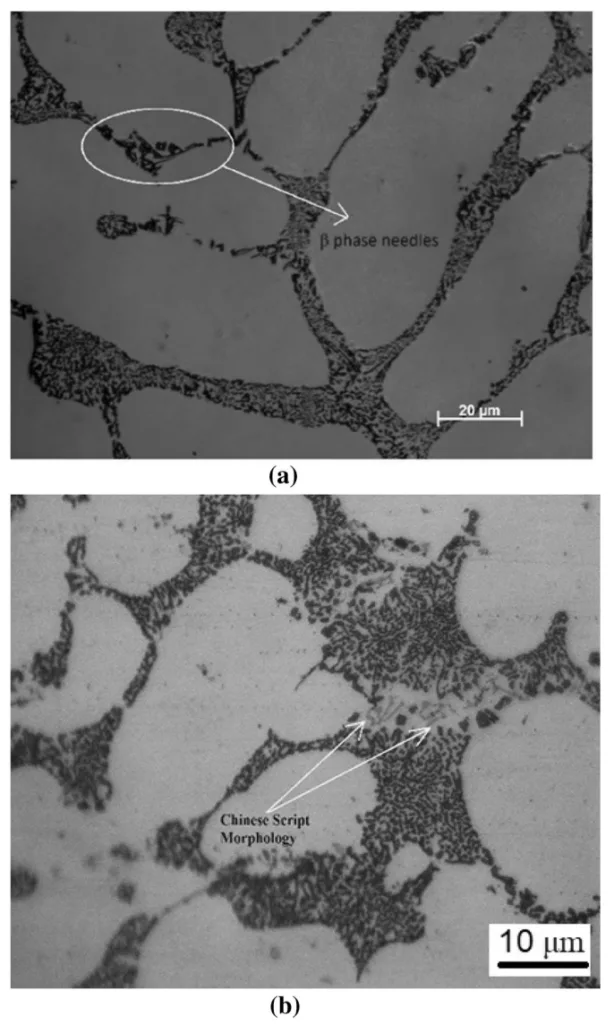この論文の要約は、"Effect of Addition of Grain Refiner and Modifier on Microstructural and Mechanical Properties of Squeeze Cast A356 Alloy"と題された論文に基づいており、"Transactions of the Indian Institute of Metals"にて発表されました。
1. 概要:
- タイトル: スクイーズ鋳造A356合金の微細組織および機械的特性に及ぼす造粒剤および改質剤添加の影響 (Effect of Addition of Grain Refiner and Modifier on Microstructural and Mechanical Properties of Squeeze Cast A356 Alloy)
- 著者: リトゥラジ・タムリー (Reeturaj Tamuly)、アミット・ベール (Amit Behl)、ヘマント・ボルカー (Hemant Borkar)
- 発表年: 2022年
- 掲載ジャーナル/学会誌: インド金属学会誌 (Transactions of the Indian Institute of Metals)
- キーワード: スクイーズ鋳造 (Squeeze casting)、造粒剤 (Grain refiner)、改質剤 (Modifier)、A356合金 (A356 alloy)

2. 研究背景:
自動車、航空宇宙、防衛などの産業において、アルミニウム-シリコン (Al-Si) 合金、特にA356グレードは、低密度と、高強度、優れた鋳造性、優れた熱伝導性、良好な耐食性および耐摩耗性などの有利な特性の組み合わせにより、広く利用されています。先行研究では、重力ダイカストAl-Si合金の機械的特性は、ホウ素やチタンなどの造粒剤、およびストロンチウムなどの改質剤の添加によって改善されることが示されています。加圧鋳造法であるスクイーズ鋳造も、アルミニウム合金の機械的特性を向上させることが知られています。
しかし、既存の研究では、マスター合金を用いて造粒および改質された鋳造Al合金へのスクイーズ鋳造の適用に関する包括的な研究には限界があります。したがって、これらの複合プロセスの影響をさらに調査する必要があります。したがって、この研究は、Al-Si合金に対する造粒および改質と組み合わせたスクイーズ鋳造の影響を調査するために不可欠です。
3. 研究目的と研究課題:
- 研究目的:
本研究は、造粒剤としてアルミニウム-チタン-ホウ素 (Al-Ti-B) 合金を添加することの効果、および微細組織改質剤として様々なレベルのストロンチウム (Sr) を含むAl-Ti-Bの複合添加の効果を、スクイーズ鋳造A356 Al-Si合金について調査することを目的としています。さらに、T6溶体化熱処理が、これらのスクイーズ鋳造合金の微細組織と機械的特性に及ぼす影響を分析します。 - 主な研究課題:
- Al-Ti-B造粒剤の添加は、スクイーズ鋳造A356合金の微細組織および機械的特性にどのような影響を与えるか?
- Al-Ti-B造粒剤とSr改質剤の複合添加は、スクイーズ鋳造A356合金の微細組織および機械的特性にどのような複合的な影響を与えるか?
- T6溶体化熱処理は、造粒剤および改質剤の添加の有無にかかわらず、スクイーズ鋳造A356合金の微細組織および機械的特性にどのような影響を与えるか?
- 研究仮説:
中心となる仮説は、造粒剤および改質剤の添加が、スクイーズ鋳造A356合金の機械的特性の向上につながるということです。さらに、熱処理の適用が、これらの強化された機械的特性をさらに増強すると仮説を立てています。
4. 研究方法
- 研究デザイン:
本研究では、スクイーズ鋳造A356合金の微細組織および機械的特性に対する造粒剤および改質剤の添加、ならびに熱処理の効果を体系的に評価するために、実験計画法を採用しました。 - データ収集方法:
本研究では、データ収集のために高度な顕微鏡観察と機械試験技術を組み合わせて利用しました。- 光学顕微鏡: 一般的な微細組織と結晶粒径の分析に使用。
- 走査型電子顕微鏡 (SEM): Si粒子および金属間化合物の形態を含む微細組織の特徴を高分解能で観察するために使用。
- エネルギー分散型分光法 (EDS): SEMと統合して、微細組織構成要素の元素組成を決定。
- 引張試験: 万能試験機を用いて、耐力、引張強度、伸び率などの機械的特性を定量化するために実施。
- 分析方法:
収集されたデータは、定性的および定量的な方法を用いて分析されました。- 微細組織分析: 顕微鏡写真からの結晶粒形態、二次デンドライトアーム間隔 (SDAS)、およびSi粒子の特徴の定性的評価。SDASの定量的測定も実施。
- 機械的特性分析: 引張試験データの統計分析により、耐力、引張強度、伸び率の平均値と傾向を決定。
- 研究対象と範囲:
本研究では、スクイーズ鋳造で加工されたA356アルミニウム合金に焦点を当てました。範囲は以下を含みます。- 合金組成: ベースラインA356合金、Al-5Ti-1B造粒剤 (Ti 750 ppm、B 150 ppm) を添加したA356、およびAl-5Ti-1B造粒剤と2つのレベル (Sr 200 ppmおよびSr 300 ppm) のAl-10Sr改質剤を組み合わせたA356。
- 加工条件: 制御されたパラメータを用いたスクイーズ鋳造プロセス、および選択されたサンプルに適用されたT6熱処理。
- 特性評価: すべての合金組成の、鋳造ままの状態と熱処理状態の両方における包括的な微細組織および機械的特性評価。
5. 主な研究結果:
- 主な研究結果:
- スクイーズ鋳造効果: スクイーズ鋳造により、A356合金の二次デンドライトアーム間隔 (SDAS) が50%大幅に減少し、45(± 2) μm から 26(± 2) μm になりました。
- 造粒効果: Al-Ti-B造粒剤の添加により、α-Al相の形態が樹枝状から球状に変化し、SDASがさらに 20(± 3) μm に減少しました。ただし、造粒剤によるSDASの減少は限定的 (6(± 1) μm) であり、これは造粒剤のフェーディング効果による可能性があります。
- 造粒および改質複合効果: Al-Ti-B造粒剤とSr改質剤の複合添加により、Si粒子およびFe系金属間化合物の形態に変化が生じました。平均SDASは、Sr添加量が200 ppmと300 ppmの両方で約 20(± 3) μm であり、SDASに対するSrの影響は限定的であることを示しています。ただし、SrはSi粒子の形態を改質するのに効果的でした。
- 熱処理効果: T6熱処理により、共晶Siの球状化と粗大化、および硬化相 (Mg₂SiおよびFe系金属間化合物) の析出が促進されました。
- 機械的特性 - 非熱処理: 造粒剤のみの添加は、引張強度 (205 MPa から 172.667 MPa へ)、耐力 (110.6 MPa から 109.3 MPa へ)、および伸び率 (10% から 6.33% へ) の低下をもたらしました。これは、造粒剤のフェーディング効果による可能性があります。造粒剤と改質剤の複合添加により、耐力は造粒剤単独の場合と比較して改善されました。
- 機械的特性 - 熱処理: 熱処理は、すべての合金組成で引張強度と耐力の両方を向上させましたが、伸び率は低下しました。熱処理されたA356 + Al-5Ti-1B + Al-10Sr (300 ppm Sr) 合金で、最高の耐力 193 MPa が達成されました。
- 統計的/定性的分析結果:
- SDASの減少: スクイーズ鋳造によりSDASが50%減少しました。造粒剤はSDASをさらにわずかに減少させました。
- 引張特性 (非熱処理): ベースA356合金は、引張強度 205 MPa、耐力 110.6 MPa、伸び率 10% を示しました。造粒剤を添加すると、これらの値は低下しました。造粒剤と改質剤を複合添加すると、耐力が回復し、伸び率は300 ppm Srで改善しました。
- 引張特性 (熱処理): 熱処理されたベースA356合金は、引張強度 235 MPa、耐力 184 MPa、伸び率 8.16% を示しました。熱処理された造粒剤および改質剤添加合金は、様々な引張特性を示し、最高の耐力は300 ppm Sr改質合金で達成されました。
- データ解釈:
結果は、スクイーズ鋳造がA356合金の微細組織を微細化するのに効果的であることを示しています。造粒は微細組織の微細化をさらに促進しますが、鋳造ままの状態では、造粒剤のフェーディングにより引張特性の低下につながる可能性があります。Sr改質剤の添加は、Si粒子の形態を部分的に改質し、造粒剤との組み合わせにより、耐力を向上させることができます。T6熱処理は、すべての合金組成で強度を最大化するために不可欠ですが、延性を低下させます。 - 図表名リスト:
- 図1 引張試験片 (すべての寸法はmm) (Fig. 1 Tensile test specimen (all dimensions are in mm))
- 図2 光学顕微鏡写真 a 鋳造ままのA356合金 b スクイーズ鋳造A356合金 (Fig. 2 Optical images of a as-received A356 alloy b squeeze cast A356 alloy)
- 図3 Al-5Ti-1Bを用いた造粒合金サンプルの光学顕微鏡写真 (倍率1種類のみ) (Ti 750 ppm、B 150 ppm) (Fig. 3 Optical images of grain refined alloy samples using Al-5Ti-1B at only one magnification (750 ppm Ti,150 ppm B))
- 図4 造粒および改質合金サンプルの光学顕微鏡写真 a Al-5Ti-1BおよびAl-10Sr (Ti 750 ppm、B 150 ppm、Sr 200 ppm) 使用; b Al-5Ti-1BおよびAl-10Sr (Ti 750 ppm、B 150 ppm、Sr 300 ppm) 使用 (Fig. 4 Optical images of grain refined and modified alloy samples a using Al-5Ti-1B and Al-10Sr (750 ppm Ti, 150 ppm B and 200 ppm Sr; b using Al-5Ti-1B and Al-10Sr (750 ppm Ti,150 ppm B and 300 ppm Sr))
- 図5 熱処理されたサンプルの光学顕微鏡写真 a Al-5Ti-1B (Ti 750 ppm、B 150 ppm) 使用; b Al-5Ti-1BおよびAl-10Sr (Ti 750 ppm、B 150 ppm、Sr 200 ppm) 使用; c Al-5Ti-1BおよびAl-10Sr (Ti 750 ppm、B 150 ppm、Sr 300 ppm) 使用 (Fig. 5 Optical images of heat-treated samples a using Al-5Ti-1B (750 ppm Ti,150 ppm B); b using Al-5Ti-1B and Al-10Sr (750 ppm Ti,150 ppm B and 200 ppm Sr); c using Al-5Ti-1B and Al-10Sr (750 ppm Ti,150 ppm B and 300 ppm Sr))
- 図6 球状化Si粒子を示す熱処理サンプルのSEM写真 a 低倍率 b 高倍率 (Fig. 6 SEM images of heat-treated samples showing spheroidized Si particles a at lower magnification b at higher magnification)
- 図7 (合金組成を明記) Mg₂Si粒子およびFe系金属間化合物の存在を示すEDS分析 (熱処理後) (Fig. 7 EDS analysis of (mention alloy composition) showing the presence of Mg₂Si particles and Fe-based intermetallics after heat treatment process)
- 図8 Al-5Ti-1Bを用いた造粒合金サンプルのSEM写真 a α-AlおよびSi共晶相 b 共晶領域における未改質Si粒子 (Fig. 8 SEM images of grain-refined alloy samples using Al-5Ti-1B a α-Al and Si eutectic phase b unmodified Si particles in eutectic zone)
- 図9 合金サンプルのSEM写真 a Al-5Ti-1B使用 Si粒子を示す b Al-5Ti-1BおよびAl-10Sr使用 Si粒子の部分改質を示す c Al-5Ti-1BおよびAl-10Sr使用 低倍率でのα-AlおよびSi共晶相を示す d Al-5Ti-1BおよびAl-10Sr使用 低倍率での共晶領域における部分改質Si粒子を示す (Ti 750 ppm、B 150 ppm、Sr 300 ppm) (Fig. 9 SEM images of alloy samples a using Al-5Ti-1B showing Si particles b using Al-5Ti-1B and Al-10Sr showing partial modification of Si particles c using Al-5Ti-1B and Al-10Sr showing α-Al and Si eutectic phase at lower magnification d using Al-5Ti-1B and Al-10Sr showing partially modified Si particles in eutectic zone at lower magnification (750 ppm Ti,150 ppm B,300 ppm Sr))
- 図10 BSE像 造粒および改質スクイーズ鋳造A356合金サンプル a A356 + Al-5Ti-1B (Ti 750 ppm、B 150 ppm) + Al-10Sr (Sr 200 ppm) b A356 + Al-5Ti-1B (Ti 750 ppm、B 150 ppm) + Al-10Sr (Sr 300 ppm) c 明るい領域を示すスペクトル10 d Fe系金属間化合物の存在を示すEDX分析 (Fig. 10 BSE image of grain refined and modified squeeze cast A356 alloy samples a A356 + Al-5Ti-1B(750 ppm Ti and 150 ppm B) + Al-10Sr (200 ppm Sr) b A356 + Al-5Ti-1B(750 ppm Ti and 150 ppm B) + Al-10Sr (300 ppm Sr) c Spectrum 10 indicating the brighter region d EDX analysis showing the presence of Fe intermetallic)
- 図11 A356合金サンプルの微細組織写真 a 未改質A356合金の光学顕微鏡写真 Fe系β相針状晶の存在を示す b Sr改質合金の光学顕微鏡写真 中国文字状形態のFe系α相金属間化合物を示す (Fig. 11 Microstructural images of A356 alloy samples a Optical image of unmodified A356alloy showing presence of Fe-based β-phase needles b Optical image of Sr-modified alloy showing Fe-based α-phase intermetallic with Chinese script morphology)



6. 結論と考察:
- 主な結果の要約:
本研究は、スクイーズ鋳造、Al-Ti-Bを用いた造粒、Srによる改質、およびT6熱処理が、A356アルミニウム合金の微細組織および機械的特性に及ぼす有意な影響を決定的に示しています。スクイーズ鋳造は、SDASを減少させることにより、微細組織を効果的に微細化します。造粒剤の添加は、α-Al相をさらに微細化し、Sr改質はSi粒子の形態を変化させます。T6熱処理は、共晶Siの球状化と析出硬化を誘導し、強度向上につながります。 - 研究の学術的意義:
本研究は、Al-Si合金に対するスクイーズ鋳造、造粒、および改質の相乗効果に関する貴重な洞察を提供します。詳細な微細組織および機械的特性評価を提供し、スクイーズ鋳造、造粒、および改質されたA356合金における相変態と強化メカニズムの理解を深めます。この知見は、材料科学および工学、特にアルミニウム合金の加工と最適化の文脈において重要です。 - 実用的な意義:
本研究の実用的な意義は、ダイカスト業界にとって非常に大きいです。本研究は、スクイーズ鋳造と造粒および改質を組み合わせることで、高性能A356合金部品を製造できる可能性を強調しています。特定された最適化された加工パラメータと合金組成は、特に高強度と軽量性が重要な要件となる自動車、航空宇宙、およびその他のエンジニアリング用途向けの鋳造部品の機械的特性を向上させるために直接適用できます。また、本研究は、ピーク機械的特性を達成するための重要な後処理プロセスとしてのT6熱処理の重要性を強調しています。 - 研究の限界:
本研究では、造粒剤の潜在的なフェーディング効果など、いくつかの限界が認められています。これは、一部の条件で微細組織の微細化と特性向上の程度を制限した可能性があります。Srによる部分的な改質は、Sr含有量のさらなる最適化の必要性を示唆しています。さらに、T6処理で使用された比較的高温の焼入れ温度は、延性に影響を与えた可能性があり、焼入れ感受性と冷却速度の最適化に関するさらなる調査の必要性を示しています。
7. 今後のフォローアップ研究:
- 今後のフォローアップ研究の方向性:
今後の研究では、特定された限界に対処し、合金組成と加工パラメータをさらに最適化することに焦点を当てる必要があります。主な方向性は次のとおりです。- Sr含有量の最適化: Si粒子の完全な改質を達成し、悪影響なしに機械的特性を最大化するための最適なSr含有量の調査。
- ホウ素含有量の最適化: フェーディング効果を軽減し、造粒効率を高めるためのAl-Ti-B造粒剤におけるホウ素の役割と最適な含有量のさらなる研究。
- 焼入れ温度の最適化: 高強度を維持しながら延性を向上させるために、T6熱処理中のより低い焼入れ温度の効果の調査。
- Sr:B比の効果: スクイーズ鋳造A356合金における効果的なSr改質と造粒のための最適なバランスを決定するためのSr:B比の詳細な研究。
- さらなる探求が必要な分野:
- フェーディングメカニズム: スクイーズ鋳造条件下でのAl-Ti-B造粒剤のフェーディングメカニズムの詳細な調査により、この効果を軽減するための戦略を開発。
- 熱処理パラメータの最適化: 溶体化温度と時間、焼入れ速度と媒体、および時効温度と時間を含むT6熱処理パラメータの体系的な最適化により、強度と延性の最良の組み合わせを達成。
- 他の改質剤の効果: スクイーズ鋳造A356合金において、優れた微細組織制御と機械的特性を達成するために、造粒剤と組み合わせて代替または複合改質剤の使用を調査。
8. 参考文献:
- Davies J R, Associates, Aluminium and Aluminium Alloys. ASM International, ASM World Headquarter, Material Park, Novelty, OH (1993)
- Jakob O, Svensson I L, Pascal L, and Dimitri D, Characterisation and investigation of local variations in mechanical behaviour in cast aluminium using gradient solidification, Digital Image Correlation and finite element simulation. Mater Design (1980-2015) 56 (2014): 755
- Kumar, P., and J. L. Gaindhar. "DAS, Solidification Time and Mechanical Properties of Al-11% Si Alloy V-Processed Castings (97-09)." Transactions of the American Foundrymen's Society 105 (1997): 635-638.
- Goulart, Pedro R., José E. Spinelli, Wislei R. Osório, and Amauri Garcia. "Mechanical properties as a function of microstructure and solidification thermal variables of Al-Si castings." Materials Science and Engineering: A 421, no. 1-2 (2006): 245-253.
- Seifeddine, Salem, Sten Johansson, and Ingvar L. Svensson. "The influence of cooling rate and manganese content on the β-Al5FeSi phase formation and mechanical properties of Al-Si-based alloys." Materials Science and Engineering: A 490, no. 1-2 (2008): 385-390.
- Ceschini, Lorella, Iuri Boromei, Alessandro Morri, Salem Seifeddine, and Ingvar L. Svensson. "Microstructure, tensile and fatigue properties of the Al-10% Si-2% Cu alloy with different Fe and Mn content cast under controlled conditions." Journal of Materials Processing Technology 209, no. 15-16 (2009): 5669-5679.
- Caceres, C. H., C. J. Davidson, J. R. Griffiths, and Q. G. Wang. "The effect of Mg on the microstructure and mechanical behavior of Al-Si-Mg casting alloys." Metallurgical and materials transactions A 30, no. 10 (1999): 2611-2618.
- Stadler, F., H. Antrekowitsch, W. Fragner, H. Kaufmann, E. R. Pinatel, and Peter J. Uggowitzer. "The effect of main alloying elements on the physical properties of Al-Si foundry alloys." Materials Science and Engineering: A 560 (2013): 481-491.
- Sritharan, T., and H. Li. "Influence of titanium to boron ratio on the ability to grain refine aluminium-silicon alloys." Journal of Materials Processing Technology 63, no. 1-3 (1997): 585-589.
- Jones, G. Pcarson, and J. Pearson. "Factors affecting the grain-refinement of aluminum using titanium and boron additives." Metallurgical Transactions B 7, no. 2 (1976): 223-234.
- Mayes, C. D., D. G. McCartney, and G. J. Tatlock. "Influence of microstructure on grain refining performance of Al-Ti-B master alloys." Materials science and technology 9, no. 2 (1993): 97-103.
- Mohanty, P. S., and J. E. Gruzleski. "Grain refinement mechanisms of hypoeutectic Al Si alloys." Acta materialia 44, no. 9 (1996): 3749-3760.
- Spittle, J. A. "Grain refinement in shape casting of aluminium alloys." International Journal of Cast Metals Research 19, no. 4 (2006): 210-222.
- Schumacher, P. "Nucleation Mechanisms during Grain Refinement of Al-Si-Alloys." Giesserei-Rundschau 50 (2003): 228-230.
- Mohanty, P. S., F. H. Samuel, and J. E. Gruzleski. "Studies on addition of inclusions to molten aluminum using a novel technique." Metallurgical and Materials Transactions B 26, no. 1 (1995): 103-109.
- Nafisi, Shahrooz, and Reza Ghomashchi. "Boron-based refiners: implications in conventional casting of Al-Si alloys." Materials Science and Engineering: A 452 (2007): 445-453.
- Lu, L., and A. K. Dahle. "Effects of combined additions of Sr and AlTiB grain refiners in hypoeutectic Al-Si foundry alloys." Materials Science and Engineering: A 435 (2006): 288-296.
- Limmaneevichitr, C., and W. Eidhed. "Fading mechanism of grain refinement of aluminum-silicon alloy with Al-Ti-B grain refiners." Materials Science and Engineering: A 349, no. 1-2 (2003): 197-206
- Ghomashchi, Reza. "The evolution of AlTiSi intermetallic phases in Ti-added A356 Al-Si alloy." Journal of Alloys and Compounds 537 (2012): 255-260.
- Lee, Choongdo. "Effect of Ti-B addition on the variation of microporosity and tensile properties of A356 aluminium alloys." Materials Science and Engineering: A 668 (2016): 152-159.
- Sokolowski, J. H., C. A. Kierkus, B. Brosnan, and W. J. Evans. "Formation of Insoluble Ti (Al, Si) 3 Crystals in 356 Alloy Castings and Their Sedimentation in Foundry Equipment: Causes, Effects and Solutions (00-21)." Transactions of the American Foundrymen's Society 108 (2000): 491-496
- Birol, Y. "Grain refinement of pure aluminium and Al-7Si with Al-3B master alloy." Materials Science and Technology 28, no. 3 (2012): 363-367.
- Couture, A. A. F. S. "Iron in aluminum casting alloys-a literature survey." International cast metals journal 6, no. 4 (1981): 9-17.
- Kori S. Auradi A V, Murty B S, and Chakraborty M. Poisoning and fading mechanism of grain refinement in Al-7Si alloy. In: Proceedings of 3rd international conference on advanced materials processing (ICAMP-3), 387-393. Processing (ICAMP-3), Melbourne, Australia, 2004.
- Haro-Rodríguez, Sergio, Rafael E. Goytia-Reyes, Dheerendra Kumar Dwivedi, Víctor H. Baltazar-Hernández, Horacio Flores-Zúñiga, and María J. Pérez-López. "On influence of Ti and Sr on microstructure, mechanical properties and quality index of cast eutectic Al-Si-Mg alloy." Materials & Design 32, no. 4 (2011): 1865-1871.
- Crosley, Phillip Bernard, and L. F. Mondolfo. "The modification of aluminum-silicon alloys." Mod Cast 49, no. 3 (1966): 99-100.
- Lu, Shu-Zu, and A. Hellawell. "The mechanism of silicon modification in aluminum-silicon alloys: Impurity induced twinning." Metallurgical Transactions A 18, no. 10 (1987): 1721-1733.
- Qiu, D., J. A. Taylor, M. X. Zhang, and P. M. Kelly. "A mechanism for the poisoning effect of silicon on the grain refinement of Al-Si alloys." Acta Materialia 55, no. 4 (2007): 1447-1456.
- Liao, Hengcheng, and Guoxiong Sun. "Mutual poisoning effect between Sr and B in Al-Si casting alloys." Scripta materialia 48, no. 8 (2003): 1035-1039.
- Timpel, M., N. Wanderka, R. Schlesiger, T. Yamamoto, N. Lazarev, D. Isheim, G. Schmitz, S. Matsumura, and J. Banhart. "The role of strontium in modifying aluminium-silicon alloys." Acta Materialia 60, no. 9 (2012): 3920-3928.
- Nogita, Kazuhiro, Stuart David McDonald, and Arne Kristian Dahle. "Effects of boron-strontium interactions on eutectic modification in Al-10 mass% Si alloys." Materials Transactions 44, no. 4 (2003): 692-695.
- Chatterjee S, Some observations on the effect of pressure on the solidification of Al-Si eutectic alloys. (1973).
- Chatterjee S, Effects of pressure on the solidification of some commercial aluminium-base casting alloys. (1972).
- Chadwick, G. A., and Tai Man Yue. "Principles and applications of squeeze casting." Metals and materials Bury St Edmunds 5, no. 1 (1989): 6-12.
- Dong, J. X., P. A. Karnezis, G. Durrant, and B. Cantor. "The effect of Sr and Fe additions on the microstructure and mechanical properties of a direct squeeze cast Al-7Si-0.3 Mg alloy." Metallurgical and materials transactions A 30 (1999): 1341.
- Okada, S., N. Fujii, A. Goto, S. Morimoto, and T. Yasuda. "Development of a full automatic squeeze casting machine." AFS Transactions 82 (1982): 135.
- Shivkumar, S., S. Ricci, B. Steenhoff, D. Apelian, and G. Sigworth. "An experimental study to optimize the heat treatment of A356 alloy." AFS Transactions 97 (1989): 791.
- Guodong, Wan Lil Luo Jirong1 Lan, and Qionghua L, Mechanical properties and microstructures of squeezed and cast hypereutectic A390 alloy [J]. J Huazhong Univ Sci Technol (Nat Sci Edition) 8 (2008).
- Ma, Z., E. Samuel, A. M. A. Mohamed, A. M. Samuel, F. H. Samuel, and H. W. Doty. "Influence of aging treatments and alloying additives on the hardness of Al-11Si-2.5 Cu-Mg alloys." Materials & Design 31 (2010): 3791.
- Ma Z, Samuel E, Mohamed A MA, Samuel A M, Samuel FH, and Doty H W. Parameters controlling the microstructure of Al-11Si-2.5 Cu-Mg alloys. Mater Design 31(2010): 3791.
- Abou El-khair, M. T. "Microstructure characterization and tensile properties of squeeze-cast AlSiMg alloys." Materials Letters 59, no. 8-9 (2005): 894-900
- Mulazimoglu M H, Electrical conductivity studies of cast Al-Si and Al-Si-Mg alloys Ph.D. Thesis, 1988, McGill University, Montreal, PQ, Canada.
- H.J Li, S. Shivkumar, X.J. Luo and D. Apelian: "Influence of Modification on The Solution Heat Treatment Response of Cast Al-Si-Mg Alloys", Cast Metals, Vol. 1, 1989, pp. 227-234
- I. Kovacs, J. Lendvai and E. Nagy: "Mechanism of Clustering in Supersaturated Solid Solutions AI-Mg2Si Alloys. "Acta Metallurgica, Vol.20, 1972, pp. 975-983.
- Gupta A K and Lloyd D J, In: Aluminum alloys, their physical and mechanical properties (ICAA3), L. Arnberg, O. Lohne, E. Nes and N. Ryum, eds. The Norwegian Institute of Technology, Trondheim, 2 (1992), 21.
- Kashyap, K. T., and T. Chandrashekar. "Effects and mechanisms of grain refinement in aluminium alloys." Bulletin of Materials Science 24, no. 4 (2001): 345-353.
- Cooper P, Hardman A, Boot D, and Burhop E, Characterisation of a new generation of grain refiners for the foundry industry." In: LIGHT METALS-WARRENDALE-PROCEEDINGS-, 923-928. TMS, 2003.
- Lu L, and Arne K. Dahle, Effects of Sr and B interactions in hypoeutectic Al-Si foundry alloys. Light metals (2006): 807.
- Spittle J A, Grain refinement in shape casting of aluminium alloys (2006): 210.
- Wang, Tongmin, Hongwang Fu, Zongning Chen, Jun Xu, Jing Zhu, Fei Cao, and Tingju Li. "A novel fading-resistant Al-3Ti-3B grain refiner for Al-Si alloys." Journal of alloys and compounds 511, no. 1 (2012): 45-49.
- Gazanion F, Grant Chen X, and Dupuis C, Studies on the sedimentation and agglomeration behavior of Al-Ti-B and Al-Ti-C grain refiners." In Materials science forum, 396, p 45-52. Trans Tech Publications Ltd, 2002.
- Schneider W, Kearns M A, McGarry M J, and Whitehead A J, A comparison of the behaviour of AlTiB and AlTiC grain refiners. In: Essential readings in light metals, p 400-408. Springer, Cham, 2016.
- Talaat M M, Salah S, Ezz S, and El-Sayed M. El-Banna. GRAIN REFINEMENT OF A1-3 AND 5% Si ALLOYS.
- Zamkotowicz Z, Stuczynski T, Augustyn B, Lech-Grega M, and Wezyk W, Investigation of grain refinement fading in hypoeutectic aluminium-silicon alloys. In: LIGHT METALS-WARRENDALE-PROCEEDINGS-, p 807-816. TMS, 2004.
- Wang, Tongmin, Yuanping Zheng, Zongning Chen, Yufei Zhao, and Huijun Kang. "Effects of Sr on the microstructure and mechanical properties of in situ TiB2 reinforced A356 composite." Materials & Design 64 (2014): 185-193.
- Tan, Pan, Yi Yang, Yudong Sui, Qudong Wang, and Yehua Jiang. "The influence of Al-10Sr or/and Al-5Ti-1B on microstructure and mechanical properties of Al-12Si-4Cu-2Ni-0.8 Mg alloys." Journal of Alloys and Compounds 809 (2019): 151856.
- Samuel A M, Doty H W, Valtierra S, and Samuel F H, Effect of grain refining and Sr-modification interactions on the impact toughness of Al-Si-Mg cast alloys. Mater Design (1980-2015) 56 (2014) 264.
- Kori S A, Auradi V, Murty B S, Chakraborty M, Poisoning and fading mechanism of grain refinement in Al-7Si alloy. In: Proceedings of 3rd international conference on advanced materials processing (ICAMP-3), p 387-393. Processing (ICAMP-3), Melbourne, Australia, 2004.
- Mohanty, P. S., and J. E. Gruzleski. "Mechanism of grain refinement in aluminium." Acta Metallurgica et Materialia 43, no. 5 (1995): 2001-2012.
- Iqbal, N., N. H. Van Dijk, S. E. Offerman, M. P. Moret, L. Katgerman, and G. J. Kearley. "Real-time observation of grain nucleation and growth during solidification of aluminium alloys." Acta Materialia 53, no. 10 (2005): 2875-2880.
- Murty, B. S., S. A. Kori, and M. Chakraborty. "Grain refinement of aluminium and its alloys by heterogeneous nucleation and alloying." International Materials Reviews 47, no. 1 (2002): 3-29
- Greer A L, Quested T E, and Spalding JE, Modelling of grain refinement in directional solidification. In: LIGHT METALS-WARRENDALE-PROCEEDINGS-, p 687-694. TMS, 2002
- Emadi D, Whiting 1 V, Sahoo M, Sokolowski J H, Burke P, and Hart M. Optimal heat treatment of A356. 2 alloy. In LIGHT METALS-WARRENDALE-PROCEEDINGS-, p 983-990. TMS, 2003.
- Croucher T, and Butler D, Polymer quenching of aluminum castings. In 26th National SAMPE Symposium, p 527-535. 1981.
- Totten G E, and Mackenzie D S Aluminum quenching technology: a review. In: Materials science forum, 331, p 589-594. Trans Tech Publications Ltd, 2000.
- Sverdlin, A. V., G. E. Totten, and G. M. Vebster. "Polyalkyleneglycol base quenching media for heat treatment of aluminum alloys." Metallovedenie i Termicheskaya Obrabotka Metallov 6 (1996): 17-19.
- Senatorova O G, Sidelnikov V V, Mihailova I F, Fridlyander I N, Bedarev A S, Spector JI, Tihonova LA Low distortion quenching of aluminium alloys in polymer medium. In: Materials science forum, 396, p 1659-1664. Trans Tech Publications Ltd, 2002.
- Beitz, H. Non-combustible water-based quenchants in forging shops for automotive parts-latest development. In: 1 st international automotive heat treating conference, p 106-109. 1998.
- Zhang, D. L., and L. Zheng. "The quench sensitivity of cast Al-7 wt pct Si-0.4 wt pct Mg alloy." Metallurgical and Materials Transactions A 27, no. 12 (1996): 3983-3991.
- Mohamed AMA, and Samuel FH A review on the heat treatment of Al-Si-Cu/Mg casting alloys. Heat treatment-conventional and novel applications (2012): 55–72.
- Wahyuningtyas P, Syahrial A Z, Putra W N, and Utomo B W. Effect of T6 on mechanical properties of TiB and Sr modified ADC12/SiC composite produced by stir casting. In: E3S web of conferences, 130, 01023. EDP Sciences, 2019.
9. 著作権:
- この資料は、リトゥラジ・タムリー、アミット・ベール、ヘマント・ボルカーの論文:「スクイーズ鋳造A356合金の微細組織および機械的特性に及ぼす造粒剤および改質剤添加の影響」に基づいています。
- 論文ソース: https://doi.org/10.1007/s12666-022-02607-4
この資料は上記の論文に基づいて要約されたものであり、商業目的での無断使用は禁止されています。
Copyright © 2025 CASTMAN. All rights reserved.